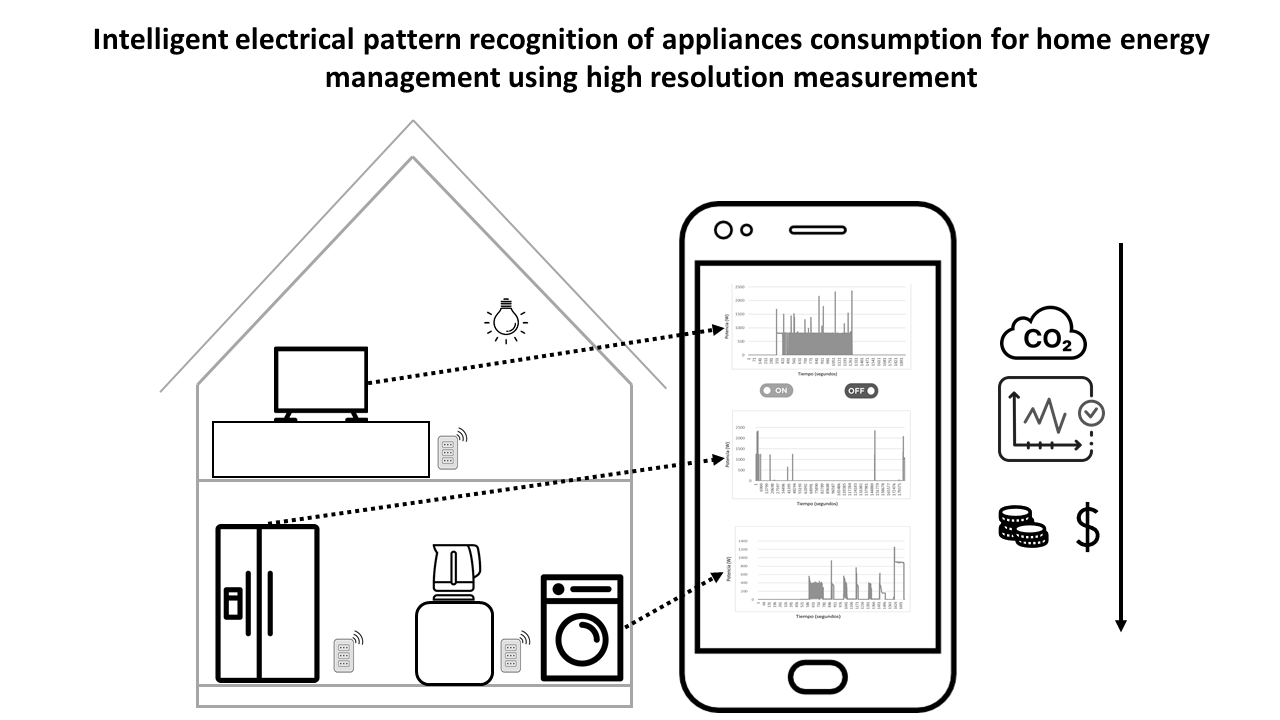Intelligent electrical pattern recognition of appliances consumption for home energy management using high resolution measurement
Keywords:
Automatic Meter Reading, Home Energy Management Systems, Intrusive Load Monitoring, Pattern Recognition, Smart SocketAbstract
For an efficient energy management by residential users, monitoring and control of connected household appliances is required. If the consumption pattern of each of these devices is identified, then the management will be more efficient, reducing both the billing and the CO2 emissions. This paper proposes a model for the recognition of energy consumption patterns in household appliances, based on the capture of electrical parameters in connected appliances, through Smart Socket with an Intrusive Load Monitoring approach. The data acquisition system corresponds to an-Internet of Things (IoT) platform that uses Automatic Meter Reading devices, connected to a IoT-gateway via Wi-Fi to send data to an application on the web. For the recognition of the patterns, machine learning techniques are used. Accuracy results on pattern identification are obtained about 91% after applying a backpropagation method in an Artificial Neural Network in time basis. Through this work, the prediction of consumer categories in household appliances, with high levels of reliability and under multiple operating states, is reached. These results enhance the efficient management of energy in a Smart Home and Smart Cities environment
Downloads
References
H. Shareef, M. S. Ahmed, A. Mohamed, and E. A. Hassan, “Review on home energy management system considering demand responses, smart technologies, and intelligent controllers,” IEEE Access, vol. 6, pp. 24498–24509, 2018. DOI: 10.1109/ACCESS.2018.2831917.
Y.H. Lin, and M.-S. Tsai, “An advanced home energy management system facilitated by nonintrusive load monitoring with automated multiobjective power scheduling,” IEEE Trans. Smart Grid, vol. 6, no. 4, pp. 1839-1851, 2015. DOI: 10.1109/TSG.2015.2388492.
T. Hasan, F. Javed, and N. Arshad, “An empirical investigation of V-I trajectory-based load signatures for non-intrusive load monitoring,” IEEE Trans. Smart Grid, vol. 5, no. 2, pp. 870-878, 2013. DOI: 10.1109/TSG.2013.2271282.
F. Paradiso, F. Paganelli, A. Luchetta, D. Giuli, and P. Castrogiovanni, “ANN-based appliance recognition from low-frequency energy monitoring data,” 2013 IEEE 14th Inter. Symp. on “A World of Wireless, Mobile and Multimedia Networks” (WoWMoM), Madrid, Spain, 2013. DOI: 10.1109/WoWMoM.2013.6583496.
T. Kato, H. S. Cho, D. Lee, T. Toyomura, and T. Yamazaki, “Appliance recognition from electric current signals for information-energy integrated network in home environments,” Ambient Assistive Health and Wellness Management in the Heart of the City, vol. 5597, pp. 150-157, 2009. https://doi.org/10.1007/978-3-642-02868-7_19.
A. Ridi, C. Gisler, and J. Hennebert, “Automatic identification of electrical appliances using smart plugs,” 2013 8th Inter. Workshop on Systems, Signal Processing and their Applications (WoSSPA), Algiers, Algeria, 2013. DOI: 10.1109/WoSSPA.2013.6602380.
A. Ridi, C. Gisler, and J. Hennebert, “A survey on intrusive load monitoring for appliance recognition,” 2014 22nd Inter. Conf. on Pattern Recognition, Stockholm, Sweden, 2014. DOI: 10.1109/ICPR.2014.636.
F. Ulloa-Vásquez, L. García-Santander, D. Carrizo, and C. Hurtado, “Towards a home energy management model through a coordinator of smart sockets,” Latvian Journal of Physics and Technical Sciences, vol. 4, no. 55, pp. 35-43, 2018. DOI https://doi.org/10.2478/lpts-2018-0027.
P. Pawar, and K. P. Vittal, “Design of smart socket for power optimization in home management system”, 2017 2nd IEEE Inter. Conf. on Recent Trends in Electronics, Information & Communications Technology (RTEICT), pp.1739-1744, 2017. DOI: 10.1109/RTEICT.2017.8256897.
S. Haykin, Neural Networks and Learning Machines, 3rd ed. Pearson, 2008.
Carlos Cruz; Esther Palomar; Ignacio Bravo; Alfredo Gardel. “Towards Sustainable Energy-Efficient Communities Based on a Scheduling Algorithm”. Sensor MDPI. Published: 14 September 2019. Sensors 2019, 19, 3973; DOI:10.3390/s19183973.
Manzoor, Awais & Ahmed, Fahim & Judge, Malik & Ahmed, Adnan & Mirza, Amaad & Khan, Zahoor & Qasim, Umar & Javaid, Nadeem. (2018). “User Comfort Oriented Residential Power Scheduling in Smart Homes”. Advances in Intelligent Systems and Computing, July 2018. DOI: 10.1007/978-3-319-61542-4. In book: Innovative Mobile and Internet Services in Ubiquitous Computing, pp.171-180.
Nagender Kumar Suryadevara; Gyan Ranjan Biswa. “Smart Plugs: Paradigms and Applications in the Smart City-and-Smart Grid”. Energy MDPI. Energies 2019, 12(10), 1957; https://doi.org/10.3390/en12101957.
A. Obushevs, I. Oleinikova and A. Mutule, “Demand side management platform for HAN flexibility estimation with agent control”, 2016 13th Inter. Conf. on the Eur. Energy Market (EEM), Porto, Portugal, 2016. DOI: 10.1109/EEM.2016.7521185.
M. N. Ullah1, N. Javaid1,2, I. Khan1, A. Mahmood2, M. U. Farooq, “Residential Energy Consumption Controlling Techniques to Enable Autonomous Demand Side Management in Future Smart Grid Communications”, 2013 Eighth International Conference on Broadband, Wireless Computing, Communication and Applications, pp.545-550, IEEE Computer Society. DOI 10.1109/BWCCA.2013.94.
F. P. Guo-ying, Y. Yu-yao, H. Guangyu, “The pattern recognition of residential power consumption based on HMM”, 2018 IEEE Conference Paper Innovate Smart Grid Technologies – Asia (ISGT Asia).


